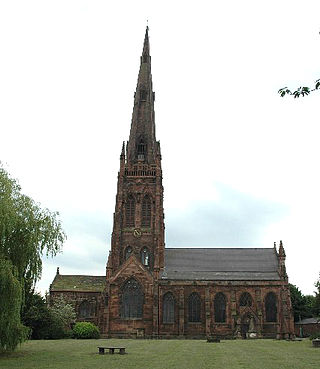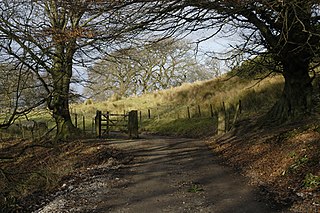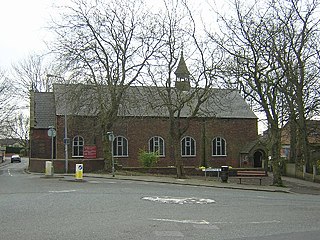Related Research Articles

Leigh is a town in the Metropolitan Borough of Wigan, Greater Manchester, England, on low-lying land northwest of Chat Moss.

St Ann's Church is a Church of England parish church in Manchester, England. Although named after St Anne, it also pays tribute to the patron of the church, Ann, Lady Bland. St Ann's Church is a Grade I listed building.
A royal peculiar is a Church of England parish or church exempt from the jurisdiction of the diocese and the province in which it lies, and subject to the direct jurisdiction of the monarch.

Prestwich-cum-Oldham was an ancient ecclesiastical parish of the hundred of Salford, within the historic county boundaries of Lancashire, England. With the Parish Church of St Mary the Virgin, Prestwich as its centre, this parish encompassed a total of ten townships, and within them, several smaller chapelries.

Deane is an area of Bolton, in Greater Manchester, England. It is about 2 miles (3.2 km) south west of Bolton and 11 miles (17.7 km) northwest of Manchester.

Mawdesley is a village and civil parish in Lancashire, England, which had a population of 1,702 as per the 2011 Census.

The Church of St Mary the Virgin is on Church Lane, Prestwich, Greater Manchester, England. It is an active Anglican parish church in the deanery of Radcliffe and Prestwich, the archdeaconry of Bolton and the diocese of Manchester. The church is recorded in the National Heritage List for England as a designated Grade I listed building. Pevsner refers to it as "a major church".

St Elphin's Church is the parish church of the town of Warrington, Cheshire, England. The church is recorded in the National Heritage List for England as a designated Grade II* listed building. It is an active Anglican parish church in the diocese of Liverpool, the archdeaconry of Warrington and the deanery of Warrington.

Belfield is an area within Rochdale, in Greater Manchester, England. It lies at the confluence of the River Beal and River Roch, 1.3 miles (2.1 km) east-northeast of Rochdale's town centre. Belfield is bound to the east by the Rochdale Canal, which forms Rochdale's common boundary with Firgrove in Milnrow.

The Parish Church of St Mary the Virgin is a Church of England parish church in Leigh, Greater Manchester, England. It is a member of the Salford & Leigh deanery in the archdeaconry of Salford, diocese of Manchester. It is recorded in the National Heritage List for England as a designated Grade II* listed building.
The church of St. John the Baptist, Leenside, Nottingham was opened in 1844 as a parish church in the Church of England. It was destroyed in 1941.

Holy Trinity Church, commonly known as Horwich Parish Church, is a Grade II listed building in Horwich, Greater Manchester, England. It is an active Church of England parish church and part of the Deane deanery in the archdeaconry of Bolton, diocese of Manchester. Holy Trinity Church is now part of the United Benefice of Horwich and Rivington, which includes the other two Anglican churches in Horwich, St Catherine's Church and St Elizabeth's Church, and Rivington Anglican Church.

Nether Wyresdale is a civil parish in Lancashire, England. In the 2001 United Kingdom census, it had a population of 613, rising to 655 at the 2011 census.

The Church of St Mary and All Saints is an Anglican church in the village of Whalley, Lancashire, England. It is an active parish church in the Diocese of Blackburn. A church probably existed on the site in Anglo-Saxon times and the current building dates from the 13th century. It is recorded in the National Heritage List for England as a designated Grade I listed building.
Richard Parr was an English bishop of Sodor and Man.

Blackfriars Bridge is a stone arch bridge in Greater Manchester, England. Completed in 1820, it crosses the River Irwell, connecting Salford to Manchester.

St Paul's Church, Peel is an active Anglican parish church in Little Hulton, Greater Manchester, England. It is part of the Diocese of Manchester and is a Grade II listed building. St Paul's serves the parish of Peel and Little Hulton and, together with St Paul's in Walkden and St John the Baptist in Little Hulton, is part of the Walkden and Little Hulton Team Ministry in the Eccles Deanery and Salford Archdeaconry.

St Mary the Virgin's Church or Ellenbrook Chapel is an active Anglican church in Ellenbrook, Worsley, Greater Manchester, England.

St John's Church, Manchester, also known as St John's, Deansgate, was an Anglican parish church in Manchester, England, established in 1769 and demolished in 1931. Its site is now that of St John's Gardens, situated between Lower Byrom Street, Byrom Street and Quay Street.

St Michael's Church, Flixton, is a Grade II* listed Church of England parish church situated in Flixton, Greater Manchester, within the Diocese of Manchester. Historically, the parish also encompassed Urmston. The church is dedicated to Michael the Archangel. Potentially a site of worship since before the Norman Conquest of 1066, the church is documented to have been established by at least 1198. From the 13th to the 19th centuries, it was under the jurisdiction of the Diocese of Lichfield.
References
- 1 2 3 4 Farrer, William; Brownbill, J., eds. (1911). "Townships: Manchester (part 2 of 2)". A History of the County of Lancaster. Vol. 4. pp. 230–251. Retrieved 23 August 2014.
- 1 2 3 Shaw, William Arthur (1894). Manchester Old and New. Vol. II. Cassell. pp. 114–118.
- ↑ Farrer, William; Brownbill, J., eds. (1911). "Manchester: The parish and advowson". A History of the County of Lancaster. Vol. 4. pp. 192–204. Retrieved 23 August 2014.
- ↑ Lawson, Richard (1898). A History of Flixton, Urmston, and Davyhulme. Richard Lawson. p. 19.
- ↑ "Parsonage Gardens Conservation Area". Manchester City Council. Retrieved 23 August 2014.
- ↑ "St. Mary's Church". Manchesterhistory.net. Retrieved 23 August 2014.